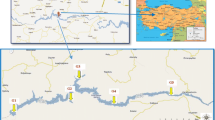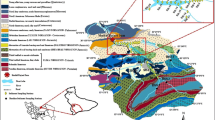Abstract
Sixty-five sediment samples and 25 water samples were collected from Al-Mujib reservoir, central Jordan, in order to investigate the heavy metal and ionic contamination assessment. Therefore, to achieve this aim, water and sediment samples were collected during winter and summer seasons (2007) from Al-Mujib reservoir and the areas surrounding it. The study shows that there are elevated levels of SO4 2−, Cl− and Na+ in reservoir water, which might originate from anthropogenic activities in the reservoir catchment area. In addition, the reservoir water has higher total hardness (TH) values together with high Ca and Mg contents. This might be attributed to pH of reservoir water and the nature of the rocks exposed in the catchment area. The average levels of heavy metals in reservoir sediments are Fe = 14,888.1, Cu = 17.8, Zn = 88.6, Ni = 38.7, Cd = 4.4, Mn = 337.9 and Pb = 6.1 mg/kg, which are lower than that observed in Wadi Al-Arab reservoir, northern Jordan. The values of enrichment factor are Cd = 35.5, Ni = 3.02, Zn = 2.54, Cu = 1.26, Mn = 1.2 and Pb = 0.57; these values indicate that heavy metals in sediments of Al-Mujeb reservoir have a different anthropogenic incrimination inputs. The study showed that the sediments are polluted with Cd, relatively contaminated with Ni and Zn and uncontaminated with respect to Mn, Pb and Cu.





Similar content being viewed by others
References
Abrahim GMS, Parker RJ (2008) Assessment of heavy metal enrichment factors and the degree of contamination in marine sediments from Tamaki Estuary, Auckland, New Zealand. Environ Monit Assess 136:227–238
Abu-Taleb F (1994) Maher, environmental management in Jordan: problems and recommendations. Environ Conserv 21:35–41
Al-Kharabsheh A, Tanny R (2003) Influence of urbanization on water quality deterioration during drought periods at South Jordan. Arid Environ 53:619–630
Al-Malahmeh M (2006) Quality of treated wastewater produced from Al-Lajoum wastewater treatment plant. M.Sc. thesis, M’tah University, Jordan
Ammary YB (2007) Waste water reuse in Jordan, present status and future plans, Jordan. Desalination 211:164–176
APHA, AWWA, WEF (1995) Standard method for the examination of water and wastewater, 19th edn. American Public Health Association/America Water Works Association/Water Environment Federation. Washington, DC
Areservoirs TM, Sanders JR (1984) The effect of the release to solution of zinc, copper, nickel from metal loaded sewage sludge. Environ Pollut (ser B) 8:85–99
Auaydeh S (2007) Chemical characteristics and the Dead Sea black mud. M.Sc. thesis, M’utah University, Jordan, p 48
Calmano W, Hong J, Forstner U (1993) Binding and mobilization of heavy metals in contaminated sediments affected by pH and redox potential. Water Sci Technol 28(8–9):22
Chapman D (1992) Water quality assessments. University Press, Cambridge
Clark RB (2001) Marpollut. Oxford University Press, Oxford, p 237
Deely JM, Fergusson JE (1994) Heavy metal and organic matter concentration and distributions in dated sediments of a small estuary adjacent to a small urban area. Sci Total Environ 153:97–111
Di Toro DM, Zarba CS, Hansen DJ, Berry WJ, Swartz RC, Coma CE, Pavlou SP, Allen ME, Thomas NA, Pasquin RP (1991) Technicalbasis for establishing sediment quality criteria for nonionic organic chemicals by using equilibrium partitioning. Environ Toxicol Chem 10:1541–1583
Dickinson WW, Dunbar GB, McLeod H (1996) Heavy metal history from cores in Wellington Harbour, New Zealand. Environ Geol 27:59–69
El-Hasan T, Al-Anbar Z, Al-Anbar M, Batarseh M, Al-Naser F, Ziadat A, Kato Y, Jiries A (2008) Removal of Zn2+ Cu2+ and Ni2+ ions from aqueous solutions via Tripoli: simple component with single phase model. Curr World Environ 3(1):1–14
EN ISO (1995) Water quality, sampling guidance on the preservation and handling of samples. The European Standard EN ISO 5667-3
Fadda E (1991) The geology of Sahab area (map sheet No. 3253 IV). Unpublished report, NRA, Amman, p 30
Ghrefat H, Yusuf N (2006) Assessing Mn, Fe, Cu, and Cd pollution in bottom sediments of Wadi Al- Arab reservoir, Jordan. Chemosphere 65:2114–2121
Harte J, Holdren C, Schneider R, Shirly C (1991) Toxics A to Z, a guide to every day pollution hazards. University of California Press, Oxford
Hornung H, Karm MD, Cohen Y (1989) Trace metal distribution on sediments and benthic fauna of Haifa Bay, Israel. Estuar Coast Shelf Sci 29:43–56
Jiries AG (2001) Chemical evaluation of treated sewage effluent in Karak Province and its suitability for irrigation purposes. Pak J Biol Sci 4(11):1400–1402
JVA/GTZ (1999) Blue print for the improvement of irrigation water management, Jordan
Kunzendrof H, Vallius H (2004) Rare earth elements (REE) in deep basin sediments of the Baltic Sea. Baltic 17(2):33–62
Kuranc A, Yurekli K (2006) Effects of Kilickaya reservoir on Concentration and load values of water quality constituents in Kelkit stream in Turkey. J Hydrol 317:17–30
Lewis DW, McConchie DM (1994) Analytical sedimentology. Chapman and Hall, New York
Loska K, Wiechula D (2003) Application of principal component analysis for the estimation of source heavy metal contamination in surface sediments from Rybnik reservoir. Chemosphere 51:723–733
MacFarlane GR, Burchett MD (2000) Cellular distribution of Cu, Pb and Zn in the Grey Mangrove Avicennia marina (Forck). Vierh Aquat Bot 68:45–59
Niencheski LF, Windom HL, Smith R (1994) Distribution of particulate trace metal in Patos Lagoon
NRA (1996) Geological map of Dhiban (Wadi Al-Mujib), sheet N. 85. Unpublished report, Amman
Nuremberg HW (1984) The voltammeter approach in trace metal chemistry of natural waters and atmospheric precipitation. Anal Chim Acta 16:1–21
Ravichandran M, Baskaran M, Santschi PH, Bianchi T (1995) History of trace metal pollution in Sabine-Neches Estuary, Beaumont, Texas. Environ Sci Technol 29:1495–1503
Rios-Arana JV, Walsh EJ, Gardea-Torresdey J (2004) Assessment of arsenic and heavy metal concentrations in water and sediments of the Rio Grand at El Paso-Juarez metroplex region. Environ Int 29:957–971
Rudnick RL, Gao S (2003) Composition of continental crust. In: Holland HD, Turekian KK (eds) Treatise on geochemistry, vol 3. Elsevier-Pergamon, Oxford, pp 1–64
Sa’ad A (1996) Rainfall-runoff relationships for urban, rural and desert sub-basins. M.Sc. thesis, University of Jordan, Amman, p 46
Sakai H, Kosima Y, Soito K (1986) Distribution of heavy metals in water and sieved sediment in the Toyoher River. Water Res 20:559–567
Salameh E (1996) Water quality degradation in Jordan, Friedrich Ebertstiftung and Royal Society for the conservation of nature, Amman, p 178
Salomons W, Förstner U (1984) Metals in the hydrocycle. Spinger, pp 63–98
Samara C, Vousta D (2005) Size distribution of airborne particulate matter and associated heavy metals in the roadside environment. Chemosphere 59:1197–1206
Schuurmann G, Market B (1998) Ecotoxicology, ecological fundamentals, chemical exposure, and biological effects. Wiley, New York
Sharma VK, Rhudy KB, Koenig R, Baggett AT, Hollyfield S, Vazquez FG (1999) Metals in sediments of Texas estuaries, USA. J Environ Sci Health, Part A: Tox Hazard Subst Environ Eng, 1532–4117, 34(10):2061–2073
Spiro T, Stigliani W (1996) Chemistry of the environment. Prentice-Hall, New Jersey
USEPA (US Environmental Protection Agency) (1986) Quality criteria for water. Office of water Regulations and Standards. Washington, DC
USEPA (US Environmental Protection Agency) (2000) Protection of environment. Code of federal regulations, 40 CFR parts 87 to 135, pp 1120–1126
USEPA (US Environmental Protection Agency) (1996) SW-846 test methods for evaluation solid waste physical/chemical methods.US Environmental Protection Agency, National Technical Information Service, Springfield
Viessman W, Hammer MJ (1998) Chemical treatment processes. Water supply and pollution control. Addison-Wesley, California, pp 438–439
WAJ (2005) Annual report of water authority of Jordan. Ministry of water and irrigation, Amman
Wen X, Allen HE (1999) Mobilization of heavy metals from Le An River sediments. Sci Total Environ 227:101–108
Windom HL, Smith RG Jr, Rawlinson C (1989) Particulate trace metal composition and flux across the south eastern US continental shelf. Mar Chem 27:283–297
Zhang J, Liu CL (2002) Revering composition and estuarine geochemistry of particulate metals in China—weathering features, anthropogenic impact and chemical fluxes. Estuar Coast Shelf Sci 54:1051–1070
Acknowledgments
The authors would like to thank the Prince Faisal center for Dead Sea, water and energy studies for providing us with analytical facilities.
Author information
Authors and Affiliations
Corresponding author
Rights and permissions
About this article
Cite this article
Manasreh, W., Hailat, I. & El-Hasan, T.M. Heavy metal and anionic contamination in the water and sediments in Al-Mujib reservoir, central Jordan. Environ Earth Sci 60, 613–621 (2010). https://doi.org/10.1007/s12665-009-0201-7
Received:
Accepted:
Published:
Issue Date:
DOI: https://doi.org/10.1007/s12665-009-0201-7




